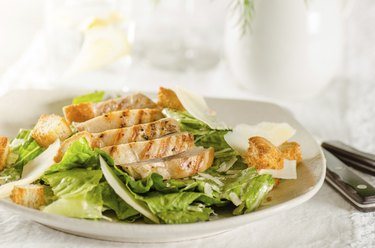
The U.S. Navy SEAL is a member of the Naval Special Warfare/Naval Special Operations community and is trained and prepared to perform in unconventional warfare in sea, air and land environments. He needs to be in peak physical shape to complete difficult missions, such as scaling the side of a vessel utilizing a caving ladder after swimming long distances with weaponry in tow in frigid water -- an assignment unique to the Navy SEAL. His demanding training involves timed runs, swims and obstacle courses, which become progressively more challenging. Proper nutrition is a cornerstone of the U.S. Navy SEAL's physical prowess, and without it his performance may be suboptimal.
General Diet Guidelines
Video of the Day
The U.S. Navy, in conjunction with the Athlete's Performance Institute, developed the "Navy Operational Fitness & Fueling Series," or NOFFS, to improve servicemen's performance through proper nutrition and training. NOFFS promotes limiting processed foods and increasing the consumption of fruits, vegetables and whole grains. In addition, the 2007 publication of "The U.S. Navy SEAL Guide to Fitness and Nutrition," edited by Patricia A. Deuster, et al., recommends that the Navy SEAL eat a diet composed of 60 to 65 percent carbohydrates, with fat accounting for less than 30 percent of the total calories and protein contributing the remaining nourishment. The high carbohydrate and protein content of the diet is necessary to fuel the Navy SEAL's intense activities and to maintain and rebuild his muscle tissue. Alterations to these general guidelines can be made to meet the Navy SEAL's specific training and combat needs.
Video of the Day
Diving and Underwater Diet Guidelines
Nutritional concerns for maritime military activities include replenishing energy and fluid losses, which are exacerbated under these conditions, particularly when conducted in cold water. The SEAL fitness guide recommends consuming high carbohydrate foods, such as pasta, rice and fruit, between missions and carbohydrate loading prior to a scheduled dive. Carbohydrate loading entails eating 1,500 extra calories from carbohydrates per day while decreasing fat and protein intake and reducing training for three days prior to the prolonged dive. The SEAL should consume fluids containing 5 to 8 percent carbohydrates periodically throughout training and missions to maintain blood sugar levels and hydration. Another goal is to replace calcium, magnesium, chromium and zinc, which are excreted in the urine at an accelerated rate during cold water immersion. These nutrients can be found in cheese and whole grains.
Temperature Extremes Diet Guidelines
The Navy SEAL trains and fights in a variety of environments that alter nutritional needs. In hot conditions, the Navy SEAL avoids fatty foods and excessive protein, which decrease heat tolerance. He also drinks beverages that contain sodium and potassium, which can be lost in sweat and result in muscle cramps. The Navy SEAL should limit the amount of fat and protein sources in a cold environment as well, because these can lead to stomach distress and water loss. Requirements for vitamins used for energy metabolism, such as thiamine, are increased in cold environments. Whole grains and nuts can provide this micronutrient.
High Altitude Diet Guidelines
Ascent to high altitude can result in significant weight loss; as a result, the Navy SEAL needs to consume 3,500 to 6,000 calories per day in such conditions. He eats small, frequent high carbohydrate meals, such as a turkey sandwich with orange juice or chocolate milk to maintain body weight. The Navy SEAL avoids protein intake greater than 10 percent of total daily calories at high altitude, because it increases fluid loss and risk for dehydration.
- America's Navy--A Global Force for Good: Navy SEALS (Sea, Air & Land)
- "The U.S. Navy SEAL Guide to Fitness and Nutrition"; Patricia A. Deuster, Ph.D., M.P.H., et al.; 2007
- Navy & Marine Corps--Public Health Center: Navy Operational Fitness and Fueling System (NOFFS)
- Navy & Marine Corps--Public Health Center: Navy Operational Fueling
- Navy Seal & SWCC Official Site: Navy SEAL General Requirements